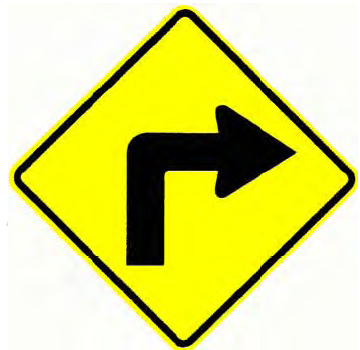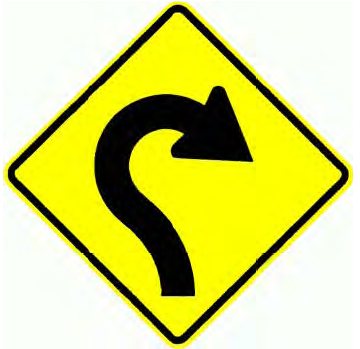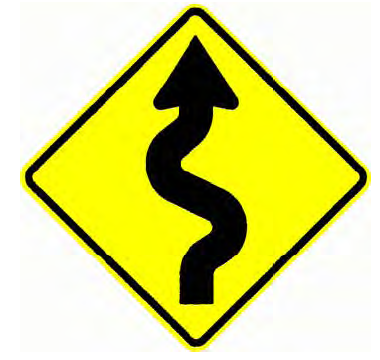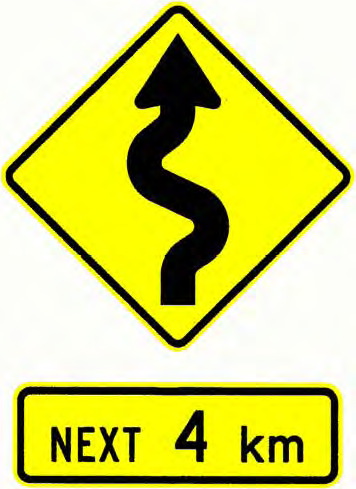A summary of advance curve warning signs is located in Table 3‑1. For special vehicle curve advisory signs see the special vehicle advisory speeds section. For specific sign details such as size and symbol height refer to the Sign specifications.
Special vehicle advisory speeds
Where these signs are installed, the following arrangements are acceptable:
On divided roads, the assembly on the right-hand side of the roadway may be installed in the median.
Arrangements with two signs should be considered where the crash record suggests that the existing advisory signage is inadequate, where a right-hand side panel would increase visibility of the arrangement, or where a curve is particularly out of context (such as after a long straight).
Table 3‑1: Typical horizontal alignment advance curve warning signs
| Sign code | Example | Description/use |
|---|---|---|
| W12-1.1 (L)/(R) Sharp curve – approximately 90° To the right or left |
 |
May be installed in combination with W12-3. Curve sign supplementary – advisory speed on the approaches to sharp curves and as appropriate where the speed warrant for curve advisory speed signing is met (Appendix A). Appendix A: Guidelines for the installation of curve warning and advisory speed signs Where the speed advisory warrant is not met the sign may be installed where the RCA considers that the curve constitutes a hazard. May be modified with a ‘concealed exit stripe’ orientated to the arrow symbol and / or used with a W12-3.3 Curve sign supplementary – concealed. No other sign apart from W12-3.2 and / or W12-3.3 can be attached to the sign or support. For sign location, see note 1. |
| W12-1.2 (L)/(R) Curve 15° to 90° To the right or left |
 |
|
| W12-1.3 (L)/(R) Curve 90° to 120° To the right or left |
 |
|
| W12-1.4 (L)/(R) Curve greater than 120° To the right or left |
 |
|
| W12-2.1 (L)/(R) Reverse curves – less than 60° To the right or left |
 |
Should be installed in combination with W12-3.2 Curve sign supplementary – advisory speed on the approaches to reverse horizontal curves where:
To identify the appropriate advisory speed, refer to two adjacent substandard curves. Two adjacent substandard curves Where the speed advisory warrant is not met, the sign may be installed where the RCA considers that the curve constitutes a hazard. May be modified with a ‘concealed exit stripe’ orientated to the arrow symbol and / or used with a W12-3.3 Curve sign supplementary – advisory speed. No other sign apart from W12-3.2 and / or W12-3.3 can be attached to the sign or support. For sign location, see note 1. |
| W12-2.2 (L)/(R) Reverse curves – greater than 60° To the right or left |
 |
|
| W12-2.3 (L)/(R) Reverse curve – decreasing radii To the right or left |
 |
Should be installed in combination with W12-3.2 Curve sign supplementary – advisory speed on the approaches to reverse horizontal curves where:
The advisory speed is displayed on the sign. Where the speed advisory warrant is not met, the sign may be installed where the RCA considers that the curve constitutes a hazard. May be modified with a ‘concealed exit stripe’ orientated to the arrow symbol and / or used with a W12-3.3 Curve sign supplementary – concealed. No other sign apart from W12-3.2 and / or W12-3.3 can be attached to the sign or support. For sign location, see note 1. |
| W12-2.4 (L)/(R) Reversed curves (less than 1 km in extent) |
 |
Should be installed in combination with W12-3.2 Curve sign supplementary – advisory speed on the approaches to sections of road 1km or less in length where there is a succession of three or more curves of varying curve advisory speed value that warrant advisory speed signing (in accordance with Appendix A:) and there is insufficient distance between the curves for separate signing. The advisory speed value displayed should be that of the first curve. Appendix A: Guidelines for the installation of curve warning and advisory speed signs Where the speed advisory warrant is not met, the sign may be installed where the RCA consider these curves constitute a hazard. No other sign apart from W12-3.2 and / or W12-3.1 can be attached to the sign or support. For sign location, see note 1. |
| W12-3.1 Curve sign supplementary – next ‘[distance]’ km |
 |
The W12-3.1 Curve sign supplementary – next ‘[distance]’ km should be installed where, in the opinion of the RCA, a winding section of road exceeding 1km in length has (due to horizontal alignment factors) an operating speed considerably below that of the remainder of the road - normally where the 85th percentile speed drops to below 50km/h and the remainder of the road has an 85th percentile speed in excess of 70km/h. W12-3.1 signs should be preceded by a curve warning/advisory speed sign combination that refers to the first curve of the section. The sign should indicate the extent of the hazardous section to the nearest even kilometre. Should not be installed where the hazardous section of road is less than 1km in length; the W12-2. Reverse curves – less than 1km in extent alone (together with a W12-3.2 Curve sign supplementary – advisory speed) as necessary should be used in preference. If the length of hazardous section is greater than 8km, additional W12-3.1 signs may be installed within the section as required. The sign should be sited at the beginning or end of the first curve which should be separately signed with the appropriate W12-1.1 – W12-2.4 together with a W12-3.2 sign (if appropriate) displaying the curve advisory speed value of the first curve in conjunction with the requirements described in note 1. |
| W12-3.3 Curve sign supplementary - concealed |
 |
Should be installed in combination with and below a modified W12-1.1 (L)/(R) – W12-2.4 (L)/(R) signs, where a minor road intersects the main route within a horizontal curve in such a location that makes it unsafe to enter the main route. An unsafe condition is considered to exist when, from a point 3m back from the edge of the nearest traffic lane, a side road driver cannot observe an approaching vehicle on the main route at a distance of at least 180m in rural situations and at least 90m in urban situations. The sign should be installed 100mm below the diamond curve warning sign, or 100mm below a W12-3.2 Curve sign supplementary – advisory speed, and on the same support. A W12-3.3 supplementary plate may also be used on approach to a location where a property entrance is concealed. |
Table 3-1 note:
| Operating speed | Distance |
|---|---|
| 50km/h | 65m |
| 70km/h | 100m |
| 80km/h | 120m |
| 90km/h | 140m |
| 100km/h | 160m |